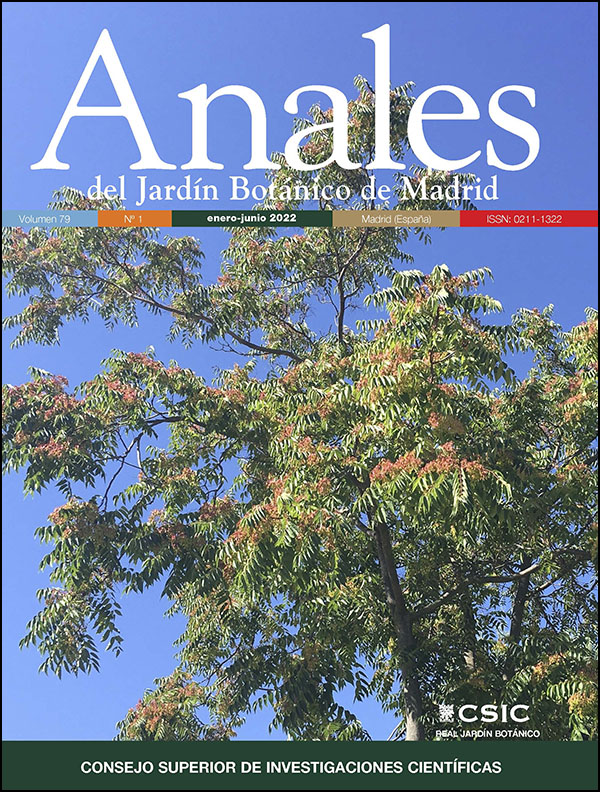Tratamiento taxonómico de Drypetes calvescens y una nueva especie en peligro de extinción del bosque pantanoso congoleño occidental, D. palustris sp. nov. (Putranjivaceae)
DOI:
https://doi.org/10.3989/ajbm.2615Palabras clave:
África central, bosques pantanosos, especie en peligro, especie nueva, estado de conservación, taxonomíaResumen
En este artículo publicamos una nueva especie arbórea de Drypetes (Putranjivaceae) de la República del Congo y la República Democrática del Congo, D. palustris, que se da en la región ecológica denominada Bosques pantanosos congoleños occidentales. Se conoce gracias a ocho recolecciones y la comparamos con la especie de morfología más parecida, D. calvescens, de la que hemos estudiado 51 recolecciones hechas en África central. Presentamos un tratamiento taxonómico de ambas especies que incluye la descripción detallada de su morfología, la tipificación de sus nombres, una tabla comparativa que resume sus principales diferencias morfológicas y una ilustración, así como información acerca de su hábitat y distribución. La evaluación provisional realizada para la Lista Roja de la UICN revela que D. palustris se encuentra En peligro y D. calvescens es de Preocupación menor.
Descargas
Citas
Bamps P. & Bouharmont J. 2010. Charles Marie Evrard (1926-2009). Plant Ecology and Evolution 143: 243-245. https://doi.org/10.5091/plecevo.2010.412
Barberá P., Quintanar A., Harris D.J. & Stévart T. 2021. Drypetes calvescens. The IUCN Red List of Threatened Species 2021: e.T174410896A174513635.
Cheek M., Ndam N. & Budden A. 2021. Notes on the threatened lowland forests of Mt Cameroon and their endemics including Drypetes burnleyae sp. nov., with a key to species of Drypetes sect. Stipulares (Putranjivaceae). Kew Bulletin 76(2) [unpaged]. https://doi.org/10.1007/s12225-021-09947-2
Dargie G.C., Lewis S.L., Lawson I.T., Mitchard E.T., Page S.E., Bocko Y.E. & Ifo S.A. 2017. Age, extent and carbon storage of the central Congo Basin peatland complex. Nature 542: 86-90. https://doi.org/10.1038/nature21048 PMid:28077869
ESRI. 2000. Arcview 3.2. Environmental Systems Research Institute, Inc., Redlands, California.
GeoCAT. 2020. Geospatial Conservation Assessment Tool. Royal Botanic Gardens, Kew. http://geocat.kew.org
Govaerts R., Frodin D.G. & Radcliffe-Smith A. 2000. World Checklist and Bibliography of Euphorbiaceae. Royal Botanic Gardens, Kew.
Grace D., Khan M.S., Friesen K. & Ata A. 2016. Antimicrobial compounds from Drypetes staudtii. Chemistry & Biodiversity 13: 913-917. https://doi.org/10.1002/cbdv.201500298 PMid:27288642
Harris D.J., Barberá P., Nguema D. & Quintanar A. 2021. Putranjivaceae Endl. in M.S.M. Sosef & al. (eds.), Flore du Gabon 57: 107-173. Margraf Publishers, Weikersheim.
Harris J.G. & Harris M.W. 1994. Plant Identification Terminology. An Illustrated Glossary. Spring Lake Publishing, Spring Lake.
IUCN Standards and Petitions Committee. 2019. Guidelines for Using the IUCN Red List Categories and Criteria. Version 14. Prepared by the Standards and Petitions Subcommittee. IUCN, Gland, Switzerland; Cambridge, United Kingdom.
Johnson S.D., Griffiths M.E., Peter C.I. & Lawes M.J. 2009. Pollinators, "mustard oil" volatiles in flowers of the dioecious tree Drypetes natalensis (Putranjivaceae). American Journal of Botany 96: 2080-2086. https://doi.org/10.3732/ajb.0800362 PMid:21622327
Pax F.A. & Hoffmann K. 1922. Euphorbiaceae-Phyllanthoideae-Phyllantheae in Engler H.G.A. (ed.), Das Pflanzenreich IV. 147, XV (Heft 81): 1-349. Wilhelm Engelmann, Leipzig.
Pole M. 1991. A modified terminology for angiosperm leaf architecture. Journal of the Royal Society of New Zealand 21: 297-312. https://doi.org/10.1080/03036758.1991.10420828
Quintanar A., Harris D.J. & Barberá P. 2020. A new species of Drypetes (Putranjivaceae) discovered by J. Léonard in the Democratic Republic of the Congo. Plant Ecology and Evolution 153: 312-320. https://doi.org/10.5091/plecevo.2020.1709
Quintanar A., Barberá P., Nguema D., Medjibe V., Goodwin Z.A., Onana J.M., Ndolo Ebika S.T., Ewango C.E.N., Moutsamboté J.M. & Harris D.J. 2021a. Lurking in the Shadows: A New Species of Drypetes (Putranjivaceae) from Central Africa Hiding in Forest Plots and Herbaria. Novon 29: 14-23. https://doi.org/10.3417/2020637
Quintanar A., Harris D.J. & Barberá P. 2021b. The Genus Drypetes (Putranjivaceae) in Liberia: An Annotated Checklist with a New Species, D. liberica. Annals of the Missouri Botanical Garden 106: 47-63. https://doi.org/10.3417/2021622
Radcliffe-Smith A. 1978. Notes on African Euphorbiaceae VII. Kew Bulletin 32: 475-481. https://doi.org/10.2307/4117118
Radcliffe-Smith A. 1987. Drypetes Vahl in Polhill R.M. (ed.), Flora of Tropical East Africa. Euphorbiaceae 1: 88-103. A.A. Balkema, Rotterdam, Boston.
Radcliffe-Smith, A. 2001. Genera Euphorbiacearum. Royal Botanic Gardens, Kew.
Stearn W.T. 1973. Botanical Latin, ed. 2. David & Charles Newton Abbot, London.
Thiers B. 2020 [continuously updated]. Index Herbariorum: A global directory of public herbaria and associated staff. New York Botanical Garden's Virtual Herbarium. http://sweetgum.nybg.org/science/ih/ [accessed 31 Dec. 2020].
Zhang L., Liu P., Sun Y., He Y., Luo N., Chen C. & Li A. 2016. Two new triterpenoids from the leaves and stems of Drypetes cumingii. Chemistry of Natural Compounds 52: 424-426 https://doi.org/10.1007/s10600-016-1664-x
Publicado
Cómo citar
Número
Sección
Licencia
Derechos de autor 2022 Consejo Superior de Investigaciones Científicas (CSIC)

Esta obra está bajo una licencia internacional Creative Commons Atribución 4.0.
© CSIC. Los originales publicados en las ediciones impresa y electrónica de esta Revista son propiedad del Consejo Superior de Investigaciones Científicas, siendo necesario citar la procedencia en cualquier reproducción parcial o total.
Salvo indicación contraria, todos los contenidos de la edición electrónica se distribuyen bajo una licencia de uso y distribución “Creative Commons Reconocimiento 4.0 Internacional ” (CC BY 4.0). Consulte la versión informativa y el texto legal de la licencia. Esta circunstancia ha de hacerse constar expresamente de esta forma cuando sea necesario.
No se autoriza el depósito en repositorios, páginas web personales o similares de cualquier otra versión distinta a la publicada por el editor.















